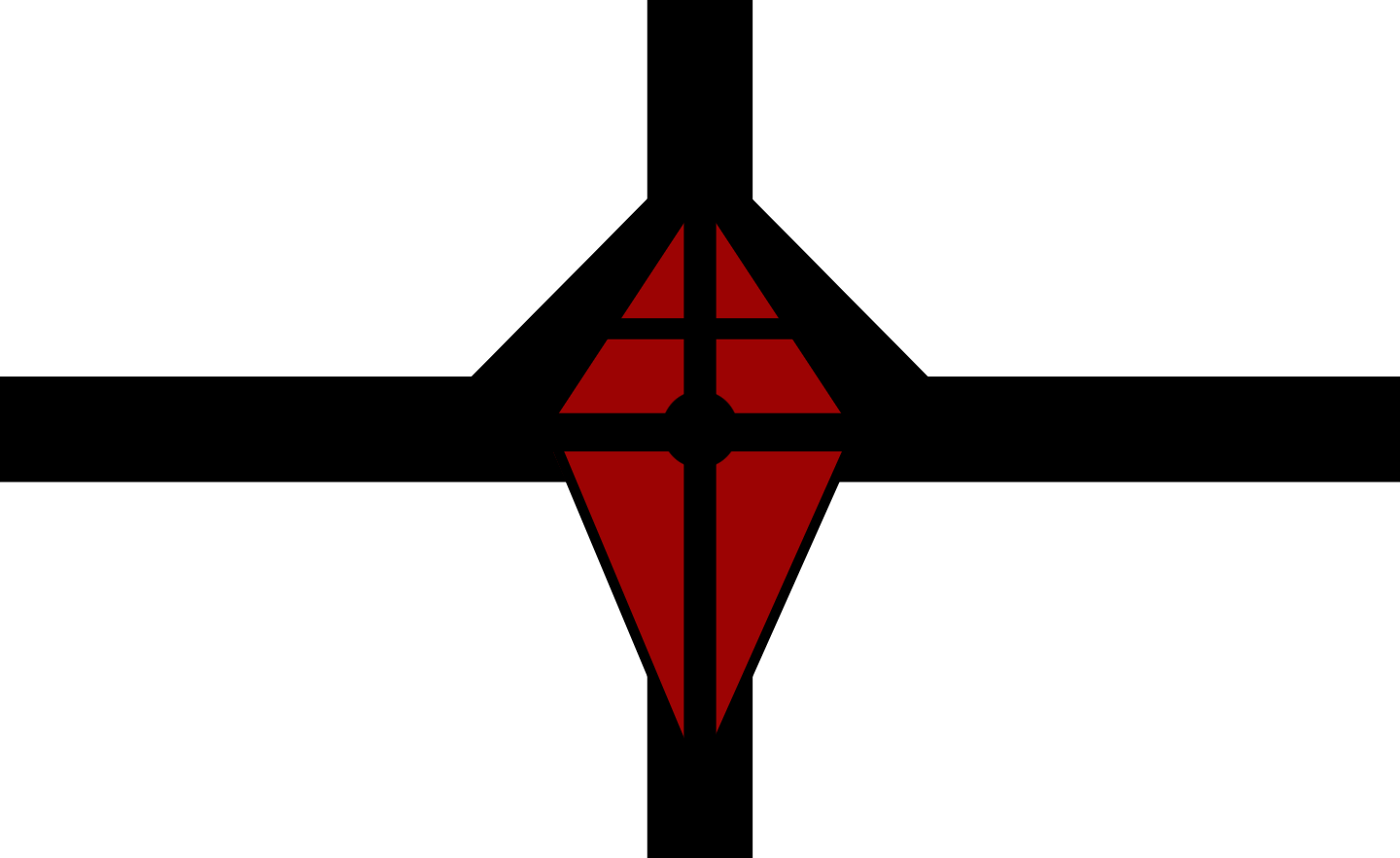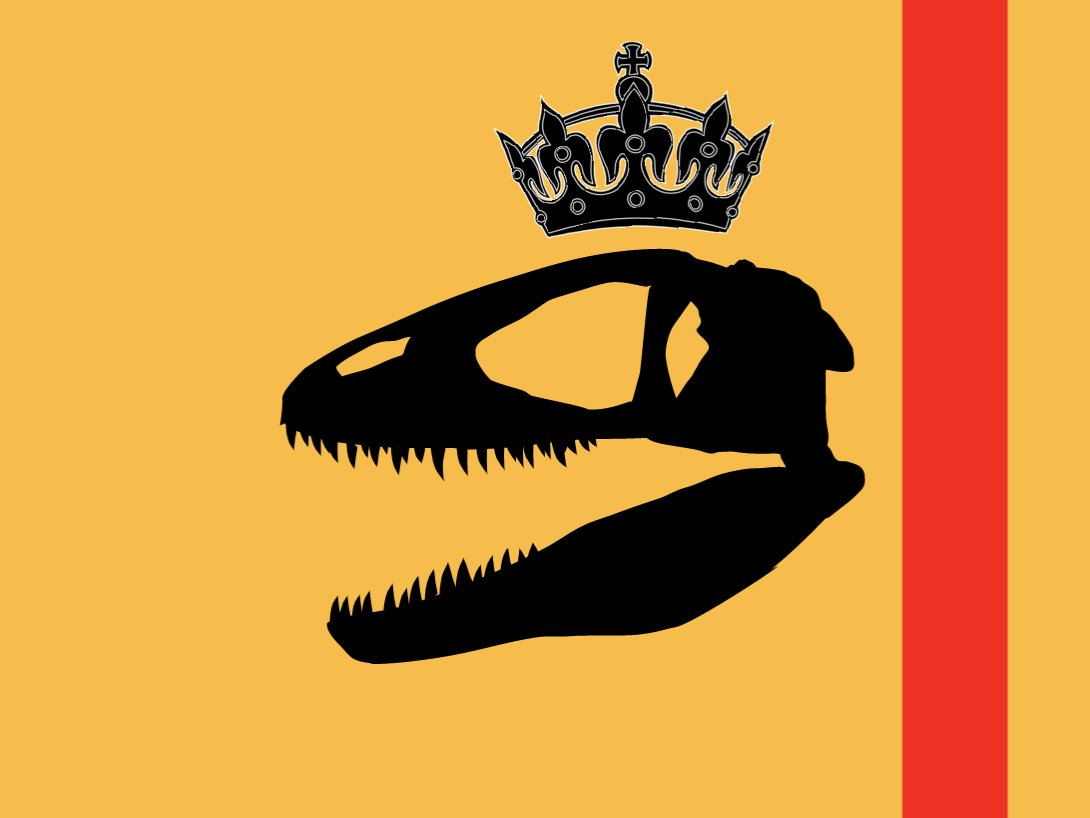Holy Dinoranian Empire
The Holy Dinoranian Empire was the Third of the Great Dinoranian Empires, founded by Dejnus III Kolsagan in 1057 CE. At its zenith, it spanned from the island territories of Sithenia Minor in the North to the holy city of Dinòroch in the South, including what became 41 territorial sub-divisions. Though Dinoraenic peoples and Esperite converts made up the bulk of its population, the Empire contained hundreds of other ethnicities. In its time, it was the largest Empire ever assembled, reaching roughly 21.2 million square kilometers and with a peak population of about 210,000,000 in 1165. In the aftermath of the Assassination of the Emperor Jadurei II, a period of unrest ensued that saw the empire slowly decline, reaching a mere quarter of its former size by 1476. The Empire finally collapsed in 1758 with the death of Emperor Dejnus X and his son Jeiahan II, both of whom perished defending Rexvil against the republican forces of neighboring Pienna. Throughout its seven centuries of dominance, the Holy Dinoranian Empire exerted a profound impact on the cultures, languages, institutions and religions of the Dinoranian Continent, and even in territories as far as Sithenia Major, Koronasland, Velrai and Erolia. The memory of the Empire has endured warmly in the hearts of the Dinoraenic Peoples, but it was not until 1983 that Pan-Dinoranian Monarchy was restored with the promulgation of the Neo-Dinoranian Empire under the Emperor Darien XI, one of the last surviving members of the Prophetic House and descendant of Dejnus III.
"Udhedra, Udhedra!" the Emperor cried, Before the great idols, shattered and defiled, "Lo, the great dark, my brothers, lies broken and slain! Forward now unto Life and to heavenly gain!" Auhorn Mediredoch, the Third Darieniyah, 7:17 (MSD Version)
Nomenclature
The name 'Dinorania' - Land of the Dinori, or Dinoraenes - was first used by the Prophet Deijen, to describe a utopian union of Dinoraenic peoples on the New Continent which he and the Exiles strove to settle. The word in this sense appears in the Espa and the Darieniyah a total of 6 times, almost entirely in quotes by the Prophet. He initially described it as a pan-dinoraenic union encompassing of the Ourasian, Dinorinic, and, eventually, Lutrian Dinoraenes. The First and Second Deijenid/Lutrian Kingdoms, however, did not use this term, preferring instead various iterations of 'Dinoraskolvad' - the Kingdom of Dinòra,' a term first put in use by the Aujenid Dynasty on the eponymous planet. Deijen's Kingdom was seen as a continuation of that which had conquered the so-called Azure Pearl, and the Ourasian and Dinorinic city-states remained fiercely independent from the Prophet-King's rule. The Union of Dinoraenes that had been proclaimed under Askaron Dinoranius Aradius in the 5th Century CE bore his name as Dinorania despite not falling under the Deijenic definition. The Askaronate of Dinorania is considered to be the first state to officially bear the name, until its reprisal by the short-lived First Republic of Dinorania in 766. The name fell into obscurity along with the Republic, and was not used again until nearly half a millennium later, when Dejnus III of the Ascanian Prophetic Devode named his Empire Dinorania in honor of both the Askaronate and his ancestor's dream of one day uniting the Dinoraenes of Gea, a feat which Dejnus had for the most part achieved by the time he proclaimed the Holy Dinoranian Empire in 1057. The Empire was often theocratic, with a complex system of Visinist Esperite worship permeating its seven centuries of existence and evolving alongside it, hence the inclusion of Holy (Tiusk Dinoranian: 'Eilage) in its name, though this was not officially part of the Empire's name until the reign of Sagarhad I 'the Pious' in the early 13th century.Prelude to an Empire
Ascania, 1014 - 1025
The Holy Dinoranian Empire was preceded in part by the Duchy of Axxan (Ascany), a breakaway Tiuskish City-state that through a combination of skilled diplomacy, the familial patronage of its native Prophetic Devode, and unmatched economic autonomy, managed to overthrow Keproskon, the Regent of Eijaddar, a Spinjavi-installed puppet ruler who governed the Kingdom of the Tiusks and Fyrans on behalf of Henrik IV the Child. In the ensuing power vaccuum, the Fyran territories disintegrated, with many chieftains seizing power, forcing a return to their former tribal ways. On the eastern side of the former kingdom, the Tiuskish territories formed a highly decentralized confederation and sought to align themselves with the Duchy of Axxan. The matter of royal succession in the Ascanian court was precarious. Fearing the ensuing turmoil and division of the family, none of the Devode's members claimed for him or herself the title of Duke. After months of deliberation, the familial patriarchs and local religious leaders agreed that the recently re-adopted 22-year old orphan Dejnus would receive the Ascanian Dukedom in light of his proven high-concentration prophetic blood, exceptional maturity, his many leader-like qualities and his martial prowess in the Esperite Temple. His utter lack of allegiance to any of the subdevodes would prevent infighting in the clan, and his youth would allow him to be influenced and advised by his family. It was agreed that the boy would carry on the image of Ahdekol (young king) that had given the rival monarch Henrik so much popular admiration, while maintaining his own visions for Ascanid dominance; his uncles and aunts would advise and influence his decision-making to that end. In July of 1825, the High Priest of the Ascanian Esparad crowned him Duke Dejnus I of Ascania, and he was received warmly by the Citizenry. From the start, the young Dejnus proved himself to be an independent, popular and just ruler. He was not totally subservient to his meddling aunts and uncles, and was an innovative reformer of judiciary, military and financial affairs even in his tender age.The Tirdevodan, the Conversion and the Massacre of 1028
In the summer of 1026, the Ascanian Devode, under pressure from its Pagan Tiusk subjects, allied itself with the Irshimén and Eselstam Devodes of the Esttiusk House of Vérrell-Esid, in addition to the Deijenic Devode of Westpien. This makeshift alliance, called the Tirdevodan ('of Four Devodes'), was based on the desire to unite Tiusk and Dinoraenic peoples in Ascania and its neighboring regions under a common national cause, and rid the region of Spinjavi and Piennic influence. Mutual suspicion and religious disputes between the Axxanitai and Vérrell-Esids characterized the Tirdevodan's first meetings. It is alleged, famously, that the Tiusk honorific word for a king, Keilin (pronounced Kye-leen) meant 'Drunkard' in the local Ascanian dialect, and the Esid patriarch Manchével was accused of referring to the young duke as such, to outrage in the Court. According to Yarvo of Axxan, the affair 'was not quite forgotten as the Ascanians' first of many poor impressions of the Westerners.' Meanwhile, the desperate Kingdom of Piennae brutally punished its Westpiennic subjects for their nationalistic heresies, and threatened the Ascanians with retaliation should they rouse any more resistance in the region. To make matters more complicated, the Fyrans under the chieftain Resquepal were making deadly incursions into Ascanian farmlands, burning windmills, killing livestock and seizing grain supplies for themselves. The threats from East, North and West put immense pressure on the Tirdevodan, and the newborn city-state of Axxan itself was threatened with famine and risked destruction. Worst of all, the boy king had disappeared. It was later discovered that he had joined the Tiuske Warriors on the frontlines, claiming that a taste of battle would finally complete his years of training with 'true experience.' He was immediately called back to the City, but did not return for another two months, causing chaos among the Axxanitai. In his time fighting alongside the Pagan Tiusks against Resquepal's Fyrans, Dejnus had converted to their Visinist Esperite religion, which at the time was considered a terrible heretical creed that threatened the hegemony of the worshippers of Darianodh, the Gatefather of Darian, and Hegemon of the Askaronate's established pantheon and Eyternium. Dejnus was immediately reprimanded by his highly religious family upon his return to Axxan, and exiled to the Tiusklands, where the patriarch Aikwall declared he 'sleep in the filth with the other unwashed heretics.' Dejnus, dishonored, vowed vengeance, and returned to the gates of the city of his nativity in 1028 with a Tiuskish army ten thousand strong, only to find that the entire Axxanitai family had been massacred in his absence. Immediately, the 25-year-old Dejnus found himself alone at the helm of a city-state on the brink of collapse. The Tirdevodan had lost the faith and allegiance of the Esperite Westpiennes, and the twin western houses squabbled over the throne. The return of the exiled king, which Dejnus had likened to Damograen's Exile of the Prophet Deijen, served as a beacon of hope among a starving populace. Dejnus was quick to take the reins, preparing his Tiuskish Armies to drive out the invaders. Resquepal, who by now had conquered all the lesser Fyran chiefdoms, and now pushed deeper into the Tùsklands, made a habit of sending the young king the entrails of his subjects in a series of wooden boxes, which, after the first, were promptly burnt upon arrival. Dejnus rallied the Tùskish Warriors, and they descended upon the Fyran-held Fortress at Mekveiri, burning it to the ground. Dejnus both commanded and fought on the frontlines, the latter with exceptional skill worthy of the Old Askaronate's famous Immortals, due in part to his training in the Esperite temple, but also due to his experience fighting the Fyran rabbles, his familiarity with the terrain and, most of all, his strong sense of brotherhood with the Tùske. As he described it, 'Each Man was a Brother, Each Blade a Bloodline. We fought as One, as Family.' Eventually, the Spinjavi border province of Hyter, held by the Fyrans, fell to Axxan, which drew the ire of Spinjav.Visin's First Arrow: the Battle of Hyderau
"You barbarian dogs would have better luck kissing the foot of [the devil] than spilling a drop of Sepenian Blood!"The Ascanian seizure of Hyter was highly controversial. Dejnus' advisors urged him not to march for the region, lest the Spinjavis be provoked. Following news that Axxan had taken Hyter, the Legions of the White Emperor Idesir IV had amassed themselves on the border almost overnight. Dejnus himself went with a delegation to the supervising Legate and negotiated carefully, requesting to speak with Idesir himself. With the Fyrans massing at Hyderau-ec-Ritva, there was no time to lose for the budding counterattackers. The Emperor, taken with the Boy King's gall, arrived in person the next morning despite a formal decline of his request. Dejnus politely stuffed his mouth with cicadas offered by the Emperor's servants, and the two spoke with blatantly contrasting Dinoranian accents and non-Dinoranian Sensibilities. The negotiations, according to testimonies of the delegates, 'were underway within minutes for Dejnus, but within hours for Idesir.' The following day, just as the Hyderau dikes failed to hold back the Fyran tide, Dejnus returned to his camp having successfully divided the region fairly between himself and the Empire. The Ascanians breathed a sigh of relief, but the most miraculous was yet to come. Controversial though his decision was, Dejnus saw the acquisition of Hyter as a resounding victory, for within its forested swamps lied an essential resource for any warmonger: mighty Tyrannosaurs. Though notoriously fierce in temperament, Tyrannosaurs in the Middle Age were not beyond taming. Dejnus had grown up on stories of the wild beasts terrorizing the borderlands, but also on the records of the Askaronate, in the age when Dinosaurs obeyed men. He had learnt the ancient Veddic Language in his time in the Temples, but was unsure if he had attained Saurophonia. The Auskeron stepped into the forest, and insisted on not being followed by his Tiuskish companions. Hours later, he returned astride a young female tyrannosaur, whom, according to analysis of her remains at the Mausoleum of Dejnus, must have weighed nearly 2,000 kilograms. Dejnus had affectionately named her Laufekeis - 'the fat lady.' The Tiuske were in awe. A tribal people with little in the manner of bestial medicine, the apparent taming of such a beast, though at times wavering, was believed to be not only impossible but, in ancient times, heretical - the Principal Demoness of the Old Alic Religion had the head of a Tyrannosaur, and she was said to devour the hearts of those that defied the Gods. Yet, here Dejnus marched such a demoness out of the blackest forest, and raised his sword in triumph over her head, almost evoking the Glyphic Image of the Deijens' Housemark - a Sword descending through a tyrannosaur's skull. A chronicler recounted the scene as 'the third rebirth of the Prophet, whose struggle and Passion were to liberate the faithful from fell, demonic overlords...' It was atop this 'fat lady' that Dejnus led his men against the Fryans, whom were almost completely routed by the sheer force of the titanic beast on the battlefield. Dejnus' forces pursued them, forcing them back against the river. The Fyran Archers stationed at Hyderau rushed into the river to support the retreating warriors, firing a barrage at the Tiuske Army. They too were overpowered, and the mighty Tyrannosaur's vocalizations boomed across the river as the barbarians were scattered, many drowning as they retreated. In battle Dejnus showed the promise of becoming a masterful tactician, utilizing ancient Askaronic Saurobellum tactics to overwhelm and overpower the disorganized Fyran ranks. He gave in to the basest of his martial passions, taking absolutely no prisoners and delighting in the vivid bloodshed as young, heavy-handed warriors often do. At the battle of Hyderau, the bulk of Resquepal's forces were crushed, and Dejnus advanced on the Terror of Axxan himself, whom cowered behind flimsy walls in his camp. His men had deserted, pillaging most of his riches and leaving for the Fyran heartlands in Lutria. Though he pleaded vigorously with the Askaron, he was sentenced to death and fed to the Tyrannosaur, a scene echoed both morbidly and comedically in the manuscripts and miniatures of the various versions of the Third Darieniyah. The Fyrans submitted to Dejnus and their territories were gradually assimilated by Axxan. On August 19th, having conquered all the territories of the former Eijad Kingdom, Dejnus had himself crowned King of Tiusks and Fyrans by right of conquest, and cemented his status by marrying the widow Marta-Celleis of the Westtiusk House of Verrell-Esid, who was almost 24 years his elder. The marriage, as well as the victories of 1028, had solidified Tiusco-Ascanian relations, and soon both ethnicities began to assimilate into a common Tiusco-Ascanian Culture united in the Visinist Faith, which the Ascanians had converted to following Dejnus' victories. The Fyrans too were forced to convert. The Dinoranian Historian Aamid recalled the time in his 1051 History of the Tiusks:A Captured Spinjavi Soldier, to Dejnus. from Mediredoch's Third Darieniyah, 2:19
"It was the beginning of a new era. For the first time in history, the Iron-god had replaced the Loving Father as Hegemon of Heaven, and soon the earth would tremble before the might of Axxan..."
The power struggles of 1029 - 1031
Ivory, interrupted
Though Resquepal's Fyrans had been dealt with, and Dejnus' Kingdom enjoyed a hard-earned prosperity, the Emperor of Spìnjav remained an important adversary. He had allegedly only yielded Hyter to the 'child' Dejnus out of pity, but, upon witnessing his ability to command tyrannosaurs in battle, grew resentful. Further still was his envy drawn by the young king's immense popularity. Though revered by his army, the allegiance of whom he had bought with bribery and intimidation, Idesir was utterly despised by the Spìnjavi populace for his excessive sense of grandeur and his many expensive personal monuments and private banquets. In early 1029, Idesir, in a 'drunken, jealous rage,' ordered his knights to seize the Hyter from the Ascanians. They reluctantly obeyed, which forced Dejnus to once again seek an audience in the White Emperor's court. Negotiations were futile, and Dejnus very nearly left the Capital of Yéreck indebted to Spìnjav rather than vice versa. Idesir, embittered by the exchange which only worsened his insecurities, revived the Eijad claim to the Tùsco-Fyran Kingdom the following day, and brought Henrik IV, who had now matured into a zealous, disgruntled man, out of exile. Henrik was sent to the Eijad-held provinces, where he declared himself the rightful King-in-exile of the Kingdom of Tùsks and Fyrans.'Little Kinglets'
Though Henrik's claim to the Kingdom was legitimate, only a few territories under control of the Eijads supported him. Dejnus described these territories, most belonging to the Eijad House of Speìdonn, as a 'pathetic and lawless confederation, one full of little Kinglets, ripe for the boot.' Upon receiving letters via the Eijads' carrier pigeons notifying them of Henrik's claim to the throne, Dejnus had all citizens loyal to Spìnjav exiled, and mounted an invasion of the Eijad-held province of Osbarron. Succeeding overnight through sheer force, Dejnus's war-chiefs captured almost all the Eijad 'Kinglet' Leaders in the province, blinding them and forcing them to crawl on hand and knee back across the Spìnjavi border. Henrik was found fleeing with his mistress, and was captured by a party of Tiuskish warriors. He was executed by Wheel of Rexvil a day later.The Wrath of Spìnjav
The death of Henrik was interpreted by Idesir as an overt declaration of war. Though Spìnjav remained plagued by popular revolts, the Emperor mustered his Knights, the conscripted White Legions, and even enlisted three Legions from the rival 'Black House' Families of the Sòrn River. The White Emperor's forces became bogged down in the former Eijad territories, and were decisively defeated at the Battle of the Osbrennes by a far smaller and less equipped Tiuskish force under the command of Dejnus' brother-in-law Rolland of Verrell-Esid.Udhedra and Visinist Reform
The Udhedra - ‘Out of Obscurity’ movement (Demonym Udhedrist) Dejnus begins a series of reforms of the Holy Esparad, destroys the Pagan Idols and formally declares Visin the one true god, the successor of Darianodh. He presents a holy book, the Third Revelation of the Dinoranian Espa, formalizing his evangelical esperite doctrine. He claims it has come to him from Heaven itself, though it is likely to have been written by him in the days between his fighting for the Tirdevodan Alliance and the war of 1028.The Asteckihaureda, 1033 - 1036
First of a series of conquests known in Dinoranian as the Asiteckihaureda, ’the Campaigns against the Heretics.’ conquers the Karlsvell (sp. Karskillijah) region from the Spinjavi Empire, the territory of Westpienna from Piennae, and the town of Mocqueadi from the Lutrian Baron Oquereid of Dinoropoli, spreads Visinist Espiritism.The Declaration of Esidoch, 1057
June 4th, 1057 - The Declaration of Esidoch - Dejnus III proclaims the Holy Dinoranian Empire, including all the territories of the Darianid Empire the relocation of the capital from Piennae to Kolskajdd (Rexvil), and the succession of Gatan Paternos/Darianodh with Visin, the Iron-god of the Old Dinoraenes. 1041 - Rexvil (Then Kolskajdd, ‘King’s City’) Founded by Dejnus III, the Tiusk Duke Luter VI Annu Va’Deijen-Stëffil and (Archbishop) Henrig Va’Verrell-Esid. The city’s modern name of Rexvil translates to ‘King’s Edict’ or ‘King’s Will.’ 1050s - the First Industrial Revolution or Kolsrevidadt. 1051 - 1052 - following a period of political upheaval, Dejnus overthrows the Consul of Lutria, installs himself as Kol Pteroi. He is hailed as a savior by the Lutrians. The territories of the Askaronate are hence restored. 1052 - 1057 - Dejnus conquers the crumbling Kingdom of Piennae and inherits the rule of its many client principalities. The Piennic King, Theregeian Thirus va’Deijen of the Piennic Devode, offers Dejnus his sword and the Piennic Crown in exchange for a respect for the Piennic Culture and autonomy of his Esparad. He grants the former, and is known in Pienna as Dejnus Rex, and, notably, by the epithet Ayenn, ‘the Redeemer.’ As for the Piennic Esparad, it was forcibly converted to the Visinist doctrine. June 4th, 1057 - The Declaration of Esidoch - Dejnus III proclaims the Holy Dinoranian Empire, including all the territories of the Darianid Empire the relocation of the capital from Piennae to Kolskajdd (Rexvil), and the succession of Gatan Paternos/Darianodh with Visin, the Iron-god of the Old Dinoraenes. 1057 - 1066 - Period of prosperity. 1066 - revolts in Rutica and the Great Continent. 1067 - Dejnus invades Sodrack, retakes the Holy City of Dinòroch from the incursions of the pagan Orsu. Installs a client state, the Protectorate of Ourasia, converts citizens to Esperitism. 1071 - Dejnus III, upon hearing in a dream that Dinorania and Esperitism were going to be attacked by an unstoppable foe, forges the Imperial out of draconite salvaged from the prow of a sunken Dejenic Quinquereme. The armor is forged by Dejnus himself and Master Blacksmith Vitharax Va’Deijen, under the supervision of the Esviok of Lord Vadan’s Eidrake. The armor’s intricate and ever-shifting engraving is done by hand using a fabled draconic technique known as Ederskuj - roughly meaning ‘Constant Motion.’ Ederskuj bordered on the metaphysical nature of Draconic art, with its extraordinarily intricate, ever-changing and difficult to recognize patterns. Vitharax allegedly commented that “Lutr’s hand is reborn in mine.” (Quote, the Kolsagarsdarieniyah). The Kingdoms of Selgrad and Northern Spinjav ally with the Holy Dinoranian Empire. Dejnus launches the Prophylactic Campaign, takes Grakia from tribal pagans. Esperite missions to Jarksvìk and Nòrumr The Martyrdom of St. Alice - Alice Aideran, a Dinoranian (nun) is killed by an envious Sithenian shaman near Stornnfell. She is declared a martyr by the (archbishop) of the Northern (diocese) The resurgent pagan Sithenian Empire massacres many settlements of Esperites in Central Sithenia Major, burns down the Ethipre of Eiraco. Dejnus and the Esparad declare war on Sithenia, and the Esperite States of Dejnara join Dejnus on his punitive conquest. The Hei’s Nomadic warriors convert to Esperitism and join the conquerors at the promise of plunder and territory. 1072 - 1098 - The Sithenian War Dejnus develops upper threshold ellurosis at 70 (~35) December 3rd, 1074 - the Battle of Lake Aihereme. Dinoranian forces crushed by Sithenian advance, Dejnus survives and flees onto the lake, where he allegedly confronted the entire Sithenian army and succeeded in defeating all of them by himself, including their notorious commander Jedverdes the Bear. The Emperor’s incredible feat of skill, stamina and swordsmanship earned him the title of Veidsankt, or Sword-saint, from the Holy Dinoranian Temple of Akshasis First instance of controlled Elluritism since the days of the Askaronate. January 18th, 1098 - Dejnus decapitates the Great Heretic Vauder, the Emperor of Sithenia, after a long and violent duel. He snaps the head of the Holy Lunar Spear, and throws Vauder’s headless body down the steps of the Crimson Palace. Dinoranian Soldiers sack Senjukta, infiltrate Holy Solil Temple, decapitate the Right Colossus and carry it back to Kolskajdd, allegedly against Dejnus’s commands. Sithenian Territories divided among Holy Dinoranian allies and nobility. The largest region, the protectorate of Snakia, belongs to the Empire, and would remain a loyal and integral region of Greater Dinorania until the fall of the Fourth Dinoranian Republic in 19(3)8. Liberation of Spinjavi Koronasland colonies from the Arumids, provinces of Aikakoron, Wirren and Seraden returned to the Spinjavi Crown. 1196 - Dejnus defeats Eviaks and Romatallites at Keie-an-Modann, establishes Rhizari, the first Dinoranian Colony on the Western Continent. 1201- Dinoranian Imperial advances halted near Romatallusi. Spread of Espiritism to Central and Southern Erolia 1214 - Death of Dejnus III at 211 years old. He is the longest-reigning monarch in postprophetic Dinoranian History Dejnusid Dynasty continues with his son, Dejnus IV, who is declared Holy Dinoranian Emperor. Reign of Dejnus V the Broad-shouldered By the time of Dejnus VI, Dinorania was no longer an Empire. Reforms of Dejnus VI First Arkic War Second Arkic War The 'Golden Age'Aleian Period
The reign of Alei I built on Dejnus VI's Golden Age, with the Dinoranian Empire expanding its territories in Velrai and Gincra.The Trade Companies
Fall of the Holy Dinoranian Empire
Holy Dinoranian Empire
Dinorisk Auskreid
Eilage Dinoriske Aukerd
Sancer Imperije Dinorænais
The Kolsgeiz, formerly the Flag of Ascania, featuring the Black Cross of the Tiuskish Pagans and the Blood Diamond of Ascany. Used as an Imperial Banner from 1028 to 1156.
The Doransjak, Banner of the Holy Dinoranian Emperor, in use from 1153 to 1156 as a personal flag, later as the Imperial State Flag. It is analogous to the modern-day flag of the Kingdom of Rexvil.
Capital:
Axxan (1025 - 1057)
Rexvil (1057 - 1758)
Notable Leaders:
Dejnus III (r. 1025 - 1214)
Dejnus X (r. 1745 - 1758)
1057 - 1758
Type
Geopolitical, Empire
Capital
Alternative Names
Empire of Dinoraenes and Allmen, Empire of the Third Revelation, Forth Empire
Formation Type
Demonym
Holy Dinoranian
Leader
Government System
Monarchy, Absolute
Currency
the Aumark
Official State Religion
Deities
Official Languages
Notable Members











Comments